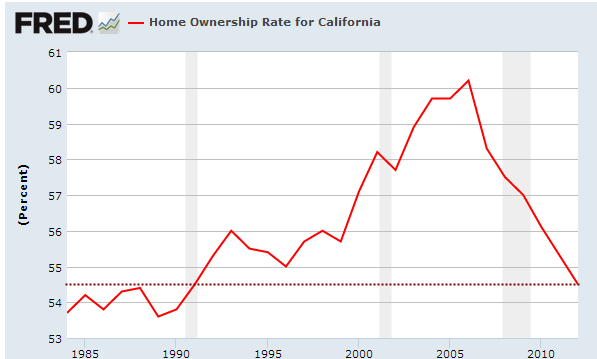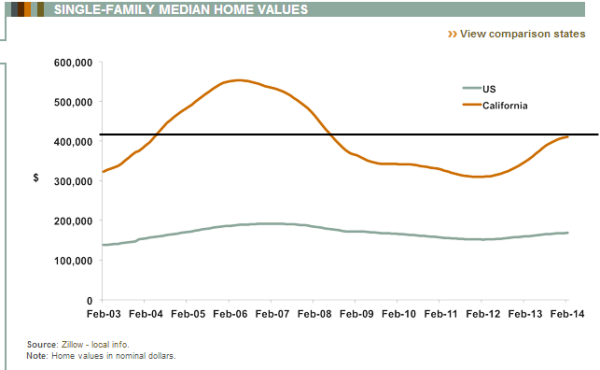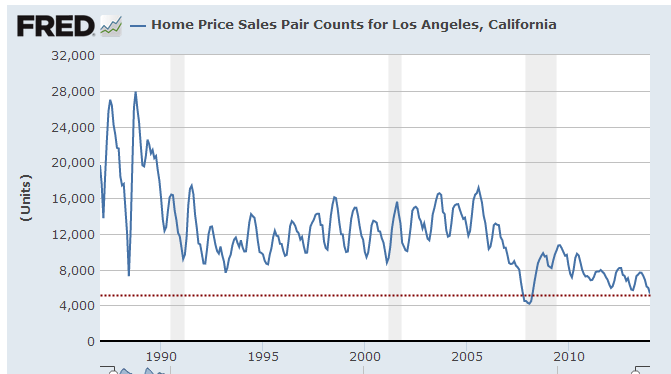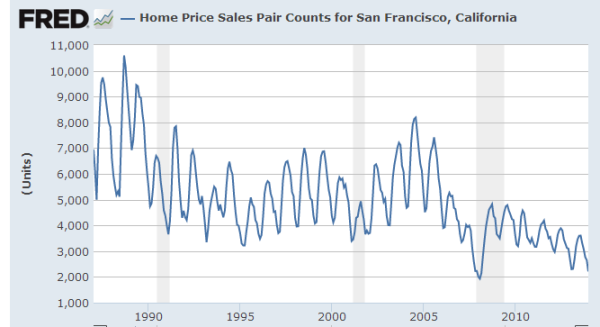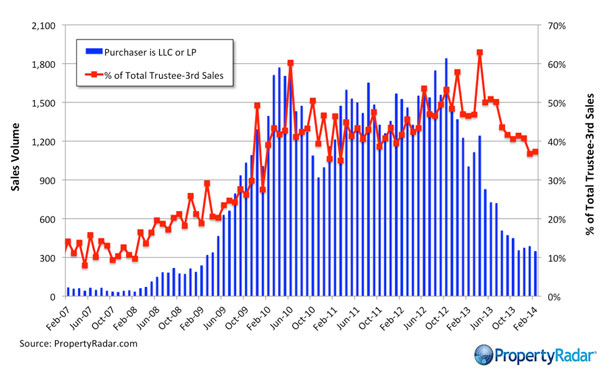A comprehensive look (see full article below) at the current state of California real estate market and why, for the most part, most Californians are priced out. With home ownership rates hitting levels not seen since the early 1990, the future of California real estate does not look bright. While the majority of market participants believe we have reached a high plateau in real estate prices and will remain here for the foreseeable future, I do not share their optimism. In fact, I believe the market will decline substantially over the next 3-5 years. To the tune of 30-50%….. in some areas of California. This decline will occur in conjunction or as a result of a severe bear market/recession (2014-2017) that our timing and mathematical work predict. If you need a more comprehensive analysis of the real estate market you can take a look at this comprehensive report Real Estate Collapse 2.0 Why, How & When
Did you enjoy this article? If so, please share our blog with your friends as we try to get traction. Gratitude!!!
Click here to subscribe to my mailing list
Will Real Estate Prices Collapse In Conjunction With The Stock Market? Google
Dr. Housing Bubble Writes: Welcome to Feudalfornia: the golden sarcophagus and the investor. Acceleration to price out masses.
California housing affordability may seem like an oxymoron. Many younger buyers are priced out in many markets across the state. The latest data from the California Association of Realtors (CAR) finds that still only 1 out of 3 families can actually afford to buy a home in the state in which they live. We also have a record number of young potential buyers (more likely potential renters) living at home with their parents. Starting in 2008 a large portion of housing sales started going to investors. These investors may have different timelines on when they will release property out into the market. In fact, this might be another big reason as to why so little inventory is out in the market. Some investors are looking to securitize cash flows and may be limited in terms of selling. Instead a regular buyer potentially looking to capitalize on equity and move up in more traditional times, you have different motivating factors. Since 2008 over 30 percent of all Californiahome sales went to this group. Another group is baby boomers locked into their golden sarcophagus. This group from what I have found for the most part is house rich and cash poor. The notion that many will sell and cash in their lottery ticket is simply not happening in the market. Many are seeing kids move back home, many still have a desire to keep their place (even if it means living in an area gentrified by dual high income households/investors), and finally a large growing rental base. In essence the continuation of California becoming more feudal is still very much intact.
Welcome renters and growing wealth gap
There is little doubt that people would like to own. The entire 2000s were dedicated to a time when anyone with a desire to buy could. The sales figures reflect this. Yet the home ownership rate is now back to where it was in the early 1990s.
We can argue that the 2000s were a time of excess. Yet remove this excess and we are back to 2000 yet the home ownership rate is now back to levels last seen in the early 1990s. Even as prices rise, the home ownership rate remains depressed:
Now how is this possible during a time when home prices went zooming up? Part of it has to do with the groups of people buying homes. The traditional home buyer is a minority in the California housing game. Low sales volume and a desire to buy from Wall Street and other investors has propelled prices higher:
The bounce statewide is unmistakable although is tapering out as investors begin to pullback. All of this is accomplished on very low sales volume:
The data used in the S&P Case Shiller figures is pulled from the Greater Los Angeles area looking at L.A. and Orange Counties (this area covers close to 13 million people) while the San Francisco-Oakland-Fremont MSA covers close to 4.5 million people. The current sales volume is lower than what we saw in the early 1990s. In fact, current sales are the lowest since the market imploded a few years ago. What gives?
The current trend was driven by low inventory, investor demand, and house lusting buyers. As investors pull-back and affordability falls, it is natural to expect volume to naturally pickup as it has. Yet California is largely becoming a renter state. We have a growing group of people that are deep into poverty:
The recession ended officially in the summer of 2009 yet we have added close to 1.5 million people to the food stamp figures. Does this reflect a booming economy? I think people in pocket markets have blinded themselves to their miniscule areas and forget that for the state overall with rising poverty, stagnant incomes, and a massive drop in housing affordability things are simply getting tougher financially. It would be one thing if prices were rising because of the big addition of good paying jobs and rising incomes. These things are absent but what isn’t is a record number of investors.
Are investors distorting the natural inventory cycle?
Investors have caused a unique boost in the housing market. The bigger play here since the crash was to buy homes for rentals. A modern day Wall Street landlord system. Big investors have been busy buying up distressed property in California:
Even in 2013 big investors were buying up over 60 percent of all distressed property. These are usually better priced deals. A good portion of foreclosures were bought before they even hit the MLS so those thinking they had a chance to buy at rock bottom prices are out to lunch (unless they had full financing to go to auctions and out-bid these people). Plus, many bought with “all cash” and then spent more money renovating – many house lusting households barely have enough to move in and furnish the place after they plop their 20 percent down payment. Clearly the dominant force here was the “all cash” buyers.
Don’t think that these investors will suddenly turn around and sell their properties even with this big rise in prices (or will run when prices correct):
“(LA Times) These are income properties for us,” Rose said. “Eventually we’ll exit, whether it’s an IPO or selling them off. But that’s years down the road.”
That is a very different mindset from the home owner or home debtor crowd. First, we still have a giant pool of underwater owners in California:
1.2 million home owners are fully in the red. Again you should look at the sales volume data above. This market is being driven by very low sales volume, tight inventory, and people simply stretching to buy. The investor crowd is pulling back:
“Prices have gotten to the stage where we cannot buy a house, renovate it, rent it and still make a reasonable return,” said Peter Rose, a spokesman for Blackstone, which owns roughly 41,000 rental houses nationwide. “There was a moment in time where it made sense.”
Among the 20 firms buying the most California real estate since January 2012, purchases are down more than 70% compared with last year in each of the last four months, according to DataQuick. At the 20 biggest foreclosure buyers, including arms of Blackstone and Colony American Holdings, purchases have fallen at about the same rate.”
As we have said big money is not dumb and the numbers just don’t work anymore. However the herd is chasing the past trend and house lusting buyers are always a part of the California market, come boom or bust. But for the large part of households in the state, many are simply looking at renting even if they want to buy based on current home prices and incomes. This isn’t 2006. You have to document your income to buy. Unfortunately the pool here is not as big as some would like to believe – hence the gap being filled by big money investors.
The assumption is that somehow, we have this massive hidden group of people ready to buy. The data shows us something completely. You have a small group that is looking to buy in very targeted markets. Yet the state overall is facing some bigger issues when it comes to housing affordability. Many boomers have underfunded retirement plans and a large part of their money is locked in their golden sarcophagus. I’ve seen it argued that people should forego retirement savings to stretch and buy a home. Some then argue that a reverse mortgage is fitting but now you are eating into any wealth you would pass onto your kids. These arguments are prevalent in California where real estate is a religion for many.
The market is changing and we will see how things go in the typically hot spring and summer months. The weather argument can only go so far. Canada doesn’t exactly have beach weather and they are more manic with their real estate. Other factors are at play here. Most of the e-mails I get are from folks in their 30s and 40s (many dual income high earners) running the numbers and wondering if buying is really a good bet. For some it is if their income is stable enough. Yet some plan on having a family and losing one income for a short period followed by the high cost of good childcare here in California. Plan on sending your kids to college? Not exactly getting cheaper there which means putting money away unless you want your kid deep in student debt.
The flood of boomers selling their homes isn’t going to happen. First, many have kids coming back home. Second, many have no desire to “downgrade” their living situation. The only way to capitalize on the golden sarcophagus is to go where housing is more affordable. From the people I’ve spoken with they have no desire to leave. They can’t even imagine going from L.A./O.C. to the Inland Empire which is less than a one hour drive. It is interesting to hear from some when they say “if I had to pay current taxes on my current home I would be priced out!” So basically what is being said is that they no longer have the income makeup of those living in their current area yet enjoy all the amenities of living in said area (i.e., schools, safety, etc). For example, in Pasadena you may have someone paying annual taxes on a property being assessed in the $200,000 range while next door someone is paying $1 million. So you have someone paying $2,000 a year or so while next door someone is paying $10,000 and more per year for the same benefits (5 times more for a similar property). You don’t see much of this across the state thankfully but it is prevalent in these tiny niche markets were dual income professionals are looking to buy.
Investors? You already got their perspective above and it is unlikely they would flood the market (especially if these are sold off to investors as income streams). Slowly inventory is rising and prices are stalling out but that does not erase the current trend. The bigger picture shows this: a growing renter class, a high number of lower income households, and a smaller group of people able to afford in certain areas. Prices are likely to correct based on the current trend but looking at income figures I doubt this is going to open up buying opportunities for most households in the state. Welcome to Feudalfornia!



